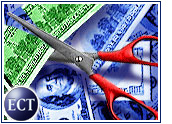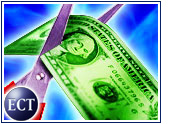So how bad a year was 2000 for e-commerce?
Think about it like this: If e-commerce is your friend, you should be arranging therapy for it right now. As 2001 approaches, e-commerce is in need of some serious time on the couch.
Symptoms? Acute anxiety. Feelings of low self-esteem. Some paranoia, inflamed by legitimate issues of abandonment. Depression, brought on by financial difficulties, unmet expectations and the traumatic deaths of several peers.
Related: How To Sustain an E-Commerce Business in a Recession
Having begun the year with youthful exuberance and pride, e-commerce ends 2000 in the throes of a mid-life crisis, no longer able to explain away its flaws as the innocent mistakes of childhood. In all seriousness, along with greater economic stability on paper, e-commerce enters 2001 in dire need of an attitude revival.
Needing an Intervention
For a reference point, consider the E-Commerce Times Stock Index, which measures 10 prominent online businesses that, as it turned out, lost a whole lot of prominence this year. At the end of 1999, the index measured 340.72. By the close of business in 2000, the index had dropped 82 percent, to 61.34.
With e-commerce in general and industry bellwether Amazon.com in particular, perception has almost often trumped reality. However, in 2000, perception took a turn for the worse.
In February, Amazon’s stock rose despite a reported net loss of US$323 million for the final quarter of 1999. Then, depending on your point of view, analysts and shareholders subsequently lost patience or came to their senses — in either case demanding that Amazon show a profit right away. No longer would promises of increasing sales revenue, or profits down the road, buttress Amazon’s stock price.
By the end of 2000, Amazon stock was barely worth more ($15.56) than the one-day gain it registered on the year 2000’s first day of trading ($13.25). Amazon finished the year down 83 percent from its 52-week high of $91.50.
Feel-Bad Syndrome
For all the doubt surrounding Amazon, the company seems positively well-adjusted compared to most of its online siblings, including those of nearly as much renown.
If any company emerged from 2000 in need of institutionalization, it was Priceline.com. The name-your-price e-tailer seemed to crave trouble this year, building up a lamentable inventory of poor financial performance ratings, expansion cutbacks, executive departures, employee layoffs, customer service complaints, lawsuits and government investigations.
Some observers are interpreting Priceline’s year-end television advertisements, which look optimistically toward 2001, as signs of denial. By comparison, once-ballyhooed online toy retailer eToys seems to have passed through denial, anger, bargaining and depression regarding its demise, moving right on in the direction of acceptance.
Despite being an early leader in the online toy market and releasing a series of high-profile television ads for the 2000 holidays, eToys said in December that it will be forced to trim its workforce and is facing the prospect of running out of cash by March.
Better Red Than Dead
Amazingly, at least 150 companies have reason to be jealous of Priceline and eToys. That number represents mergers and acquisitions tracking firm Webmergers’ estimate of the number of dot-coms that folded in 2000.
Among the bigger names that gave up the ghost were: Boo.com and Toysmart.com in May, Petstore.com in June, Living.com in August, Pop.com (which was never even able to begin operations) in September, WebHouse Club and Eve.com in October, and Pets.com, MotherNature.com and Garden.com in November.
For a six-week period in October and November, dot-coms were closing at a rate of approximately one per day. Somehow, e-commerce will have to get out of bed every morning knowing that the carnage doesn’t figure to end with the year 2000.
Over Its Shoulder
Meanwhile, as e-commerce tries to rebuild its psyche in 2001, it will also be plagued with the memory from 2000 that even when business is going relatively well, the industry has not yet learned how to protect itself from technical glitches.
In what was perhaps the first sign that 2000 was not going to be a year of living effulgently for e-commerce, February brought a series of denial-of-service (DoS) attacks on prominent Web sites, including Yahoo!, Amazon, Buy.com, eBay and CNN.com.
The attacks, which overloaded the Web sites with repeated data requests, eliminated the notion that hackers would be merely an annoyance for e-commerce. Soon after, a study by Information Week Research for PricewaterhouseCoopers predicted that hacker attacks would cost the world economy US$1.6 trillion in 2000.
“It’s not a matter of if America has an electronic Pearl Harbor; it’s a matter of when,” Republican Congressman Curtis Weldon (D-Pennsylvania), a member of a government Internet crime committee, told the Pentagon in July.
Inferiority Complex
As winter approached, all the swelling negativity put e-commerce under a microscope in a way the industry could not have imagined 12 months earlier. The holiday shopping season was characterized in most circles as do-or-die, and every day people watched for blunders.
This being 2000, people did not have to wait long. Immediately after Thanksgiving, customer (and automated shopping bot) traffic overflows caused service outages that slowed or temporarily KOed the sites of companies like Amazon, Bestbuy.com, eToys and BlueLight.com.
Customer service, perhaps e-commerce’s main plague during the otherwise carefree days of 1999, also remained an issue. Amazon partner Toysrus.com, for one, found itself scrambling to restock some items that had been heavily bought in early shopping.
Very Half Empty
By December, study after study reported on the level of holiday online sales in ways that were quite predictable. Holiday e-commerce: good but not good enough.
As if it could have been any other way. Even though, according to some reports, online shopping had more than doubled over 1999, e-commerce watchers easily found the clouds surrounding the silver lining.
For example: Goldman Sachs and PC Data Online reported that Net holiday sales through the first full week of December were up 115 percent from the same period last year — but below the 170 percent year-over-year gain seen at this time last year. That represented a “much faster decline than expected,” Goldman analyst Anthony Noto wrote in a report.
“I’m Good Enough”
With all the baggage that it found itself with in 2000, maybe it would not be all that surprising if e-commerce just gave up and put itself on the auction block.
Of course, even that kind of action would recall a disturbing aspect of e-commerce’s year, the hoax surrounding July’s auction on eBay of F**dCompany.com, a satiric Web site that — what else — tracks failed and failing dot-coms.
Nope, in 2001, e-commerce is going to have to get up off the therapist’s couch and try again. It will tell itself very simply, “Whatever does not kill us makes us stronger.”






















































Social Media
See all Social Media